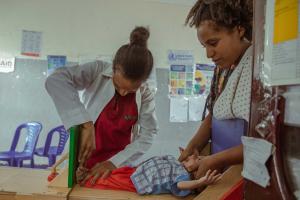Integrating Nutrition Surveillance into Routine Health Services in the Amhara Region, Ethiopia
In Amhara region, Ethiopia, where communities have long battled the harsh impacts of drought and disease outbreaks, a transformative initiative has taken root. It began with a coalition of global health partners—World Health Organization, European Commission Humanitarian Aid, the United States Agency for International Development, and the United Nations Central Emergency Response Fund —joining hands with local authorities to address a pressing issue: acute malnutrition among children.
Amidst the challenges posed by frequent droughts affecting over 1.8 million people, the need for robust nutrition surveillance became evident. In 2023, only 52.2% of the region was covered by nutrition screenings, highlighting a critical gap in healthcare response. Determined to change this narrative, a comprehensive training program was launched. Over three intensive days, more than 1,350 healthcare workers, ranging from seasoned professionals to dedicated community health workers, gathered to learn the intricacies of nutrition surveillance.
Led by experts from WHO and supported by the Amhara Regional Health Bureau, the training delved into data collection, analysis, and interpretation techniques. Practical sessions equipped participants with the skills needed to conduct effective nutrition screenings and to identify early signs of malnutrition among vulnerable populations.
The impact of this initiative was swift and profound. Within weeks, healthcare workers began to report a surge in admissions to therapeutic feeding programs. Children who previously suffered silently from severe malnutrition were now receiving timely medical attention, thanks to improved detection and swift referrals facilitated by the newly trained health workers.
One such success story involved Fatima, a two-year-old girl from a remote village in the drought-affected zone. During a routine nutrition screening conducted by a local health extension worker, Fatima was identified as severely malnourished. Swift action was taken: she was immediately referred to a nearby health center where she received life-saving treatment. Today, Fatima is thriving, a testament to the power of early detection and coordinated healthcare efforts.
Reflecting on the initiative, Dr. Ahmed, a public health officer involved in the program, remarked, "The collaboration between international partners and local authorities has been crucial in revitalizing our approach to healthcare. By integrating nutrition surveillance into routine health services, we are not just treating illnesses but preventing them—a paradigm shift in our region."
As the program continues to expand its reach, there is optimism about its long-term impact on community health resilience. The story of Fatima and countless others like her serves as a driving force, illustrating how proactive intervention and collaborative efforts can save lives and pave the way for a healthier future in Ethiopia's Amhara region.
Technical contact
Dereje Tadesse
Medical Officer - Nutrition
tadessed [at] who.int (tadessed[at]who[dot]int)



